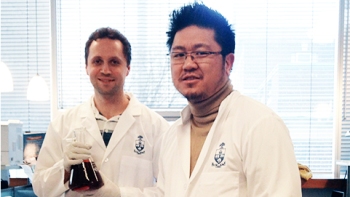Mar 1 2013
A diagnostic ‘cocktail,’ containing a single drop of blood, a dribble of water and a dose of DNA powder with gold particles, could one day lead to the treatment of the world’s leading diseases.
 IBBME PhD student Kyryl Zagorovsky and Professor Warren Chan.
IBBME PhD student Kyryl Zagorovsky and Professor Warren Chan.
This homegrown brew is being developed by IBBME PhD student Kyryl Zagorovsky and Professor Warren Chan (IBBME), a Canada Research Chair in Nanobiotechnology, and a recent winner of the NSERC E.W.R. Steacie Memorial Fellowship.
“There’s been a lot of emphasis in developing simple diagnostics,” said Professor Chan. “The question is, how do you make it simple enough, portable enough?”
Professor Chan’s lab studies nanoparticles – in particular, the use of gold particles in sizes so small that they are measured in the nanoscale. He and his group are working on custom-designing nanoparticles to target and illuminate cancer cells and tumours, with the potential of one day being able to deliver drugs to cancer cells.
Zagorovsky’s rapid-diagnostic biosensor will allow technicians to test for multiple diseases at one time with one small sample, and with high accuracy and sensitivity. The biosensor relies upon gold particles in much the same vein as your average pregnancy test. With a pregnancy test, gold particles turn the test window red because the particles are linked with an antigen that detects a certain hormone in the urine of a pregnant woman.
“Gold is the best medium,” explained Professor Chan, “because it’s easy to see. It emits a very intense colour.”
Currently, scientists can target a particular disease by linking gold particles with DNA strands. When a sample containing the disease gene (e.g., Malaria) is present, it clumps the gold particles, turning the sample blue.
Rather than clumping the particles together, Zagorovsky immerses the gold particles in a DNA-based enzyme solution (DNA-zyme) that, when the disease gene is introduced, ‘snip’ the DNA from the gold particles, turning the sample red.
“It’s like a pair of scissors,” said Zagorovsky. “The target gene activates the scissors that cut the DNA links holding gold particles together.”
The advantage is that far less of the gene needs to be present for the solution to show noticeable colour changes, amplifying detection. A single DNA-zyme can clip up to 600 ‘links’ between the target genes.
Just a single drop from a biological sample such as saliva or blood can potentially be tested in parallel, so that multiple diseases can be tested in one sitting.
But the team has also demonstrated that can transform the testing solution into a powder, making it light and far easier to ship than solutions, which degrade over time. Powder can be stored for years at a time, and offers hope that the technology can be developed into efficient, cheap, over-the-counter tests for diseases such as HIV and malaria for developing countries, where access to portable diagnostics is a necessity.
“We’ve now put all the pieces together,” said Professor Chan.